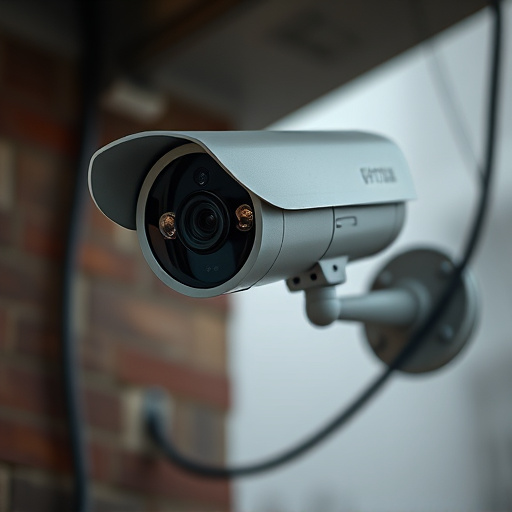Planning a mock surveillance system with Fake Dome Bullet Cameras requires understanding camera types and strategic placement for optimal coverage. Position cameras discreetly in hallways and entryways, focusing on blind spots and key intersections. Install them in well-lit areas, align lenses, and connect to power sources. Test the system through simulated scenarios, calibrating for clear views, image quality, and tracking performance to ensure reliable monitoring.
“Enhance your home or business security with our comprehensive guide to installing mock surveillance systems. This step-by-step tutorial covers everything from understanding various fake dome bullet camera types and specifications, to strategizing optimal placement for maximum coverage. Learn how to install these cameras effectively and calibrate your system for precise monitoring. Discover expert tips on ‘Fake Dome Bullet Camera Placement’ to create a robust, yet cost-effective security network.”
- Understanding Fake Dome Bullet Camera Types and Specifications
- Planning Strategic Fake Dome Camera Placement for Optimal Coverage
- Step-by-Step Guide to Installing Fake Dome Bullet Cameras
- Testing and Calibrating Your Mock Surveillance System Effectively
Understanding Fake Dome Bullet Camera Types and Specifications
When considering a mock surveillance system, understanding the various types and specifications of fake dome bullet cameras is paramount. These cameras mimic real security equipment in appearance but serve as placeholders for actual surveillance devices. They come in different sizes, resolutions, and features, each designed for specific placement needs. For instance, smaller models are ideal for indoor spaces like offices or retail stores, offering basic monitoring with HD video quality. Conversely, larger, high-resolution cameras are suited for outdoor environments, providing clearer images even in low light conditions.
The fake dome bullet camera’s design is crucial for realistic placement. Their dome shape allows them to be mounted on various surfaces discreetly, mimicking the appearance of genuine surveillance equipment. This versatility enables you to strategically position them in hallways, entryways, or any common areas to create a comprehensive security network. Remember, the goal is to create an authentic-looking setup that deters potential intruders while providing peace of mind.
Planning Strategic Fake Dome Camera Placement for Optimal Coverage
When planning the strategic placement of fake dome bullet cameras, the goal is to achieve optimal coverage while maintaining a realistic and unobtrusive appearance. Begin by thoroughly assessing the area to be monitored, taking note of potential blind spots where real or hidden cameras might be needed. Identify key points such as intersections, entryways, and common gathering areas, ensuring these are within clear view.
Consider both vertical and horizontal angles, positioning cameras high enough to capture a wide area but not so high that they become conspicuous. Arrange the dome cameras in a way that creates layers of surveillance, allowing for comprehensive coverage without creating an obvious security network. This strategic placement will help deter potential intruders while providing peace of mind with a seemingly random yet effective security system.
Step-by-Step Guide to Installing Fake Dome Bullet Cameras
Installing fake dome bullet cameras is a straightforward process that involves careful placement for optimal security coverage. Begin by selecting the desired locations for each camera, ensuring strategic points around your property offering clear lines of sight. These locations should be well-lit and visible from multiple angles to maximize deterrence.
Next, mount the cameras on sturdy tripods or walls using the provided hardware. Align the lenses for crisp picture quality and adjust the camera angle as needed. Once secure, connect each camera to a power source through the included cables, ensuring all components are properly grounded for stability. Test the systems to verify clear audio and video feed before finalizing the placement for a comprehensive mock surveillance system.
Testing and Calibrating Your Mock Surveillance System Effectively
Testing and calibrating your mock surveillance system effectively is crucial for accurate and reliable monitoring. Start by simulating various scenarios, such as movements within different zones covered by your Fake Dome Bullet Cameras. Observe the camera’s field of view, ensuring objects and individuals are clearly captured without obstructions. Adjust the placement of these cameras strategically to maximize coverage and minimize blind spots.
Next, verify image quality and clarity by checking the system’s feed during testing. Ensure the mock surveillance system accurately tracks movements and triggers alerts as expected. Regular calibration will help maintain optimal performance, especially in dynamic environments. Pay close attention to the camera’s focus, ensuring it remains sharp and stable, even when capturing fast-moving objects or subjects.
Installing a mock surveillance system with fake dome bullet cameras offers an effective way to enhance security while testing real camera placement. By understanding different camera types, strategically planning their placement for optimal coverage, and following a step-by-step installation guide, you can create a realistic simulation. Testing and calibrating the system ensures accurate monitoring, providing a valuable tool for both security professionals and those seeking to improve their facility’s protection. Remember, proper fake dome bullet camera placement is key to achieving effective surveillance.
